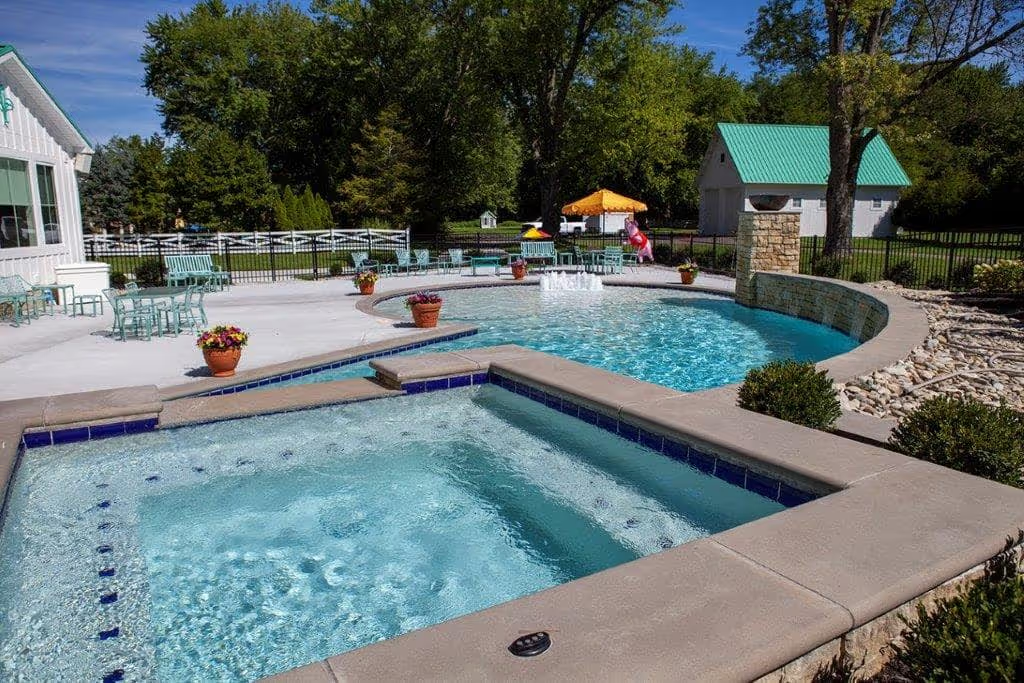- Stone Center
- Blog
Natural Stone vs. Brick Fireplace: Pros, Cons & Key Features Explained
26/8/2025
8/13/2025
Natural Stone vs. Brick Fireplace: Pros, Cons & Key Features Explained

When Ohio winters settle in, and you're planning the perfect family room centerpiece, choosing between a brick fireplace or a stone fireplace becomes one of the most important decisions for your home.
Picture yourself on a snowy evening, watching flames dance against beautifully crafted limestone fireplace surrounds or classic red brick — each material creates a unique atmosphere and tells a different story about your home's character.
Both natural stone fireplaces and brick alternatives create stunning focal points, but they differ significantly in cost, installation complexity, and long-term maintenance requirements. So, which one is best for you? In this comprehensive guide, the Stone Center team breaks down everything you need to know about brick vs. stone fireplaces to make the right choice for your home and budget, from initial investment to resale value considerations.
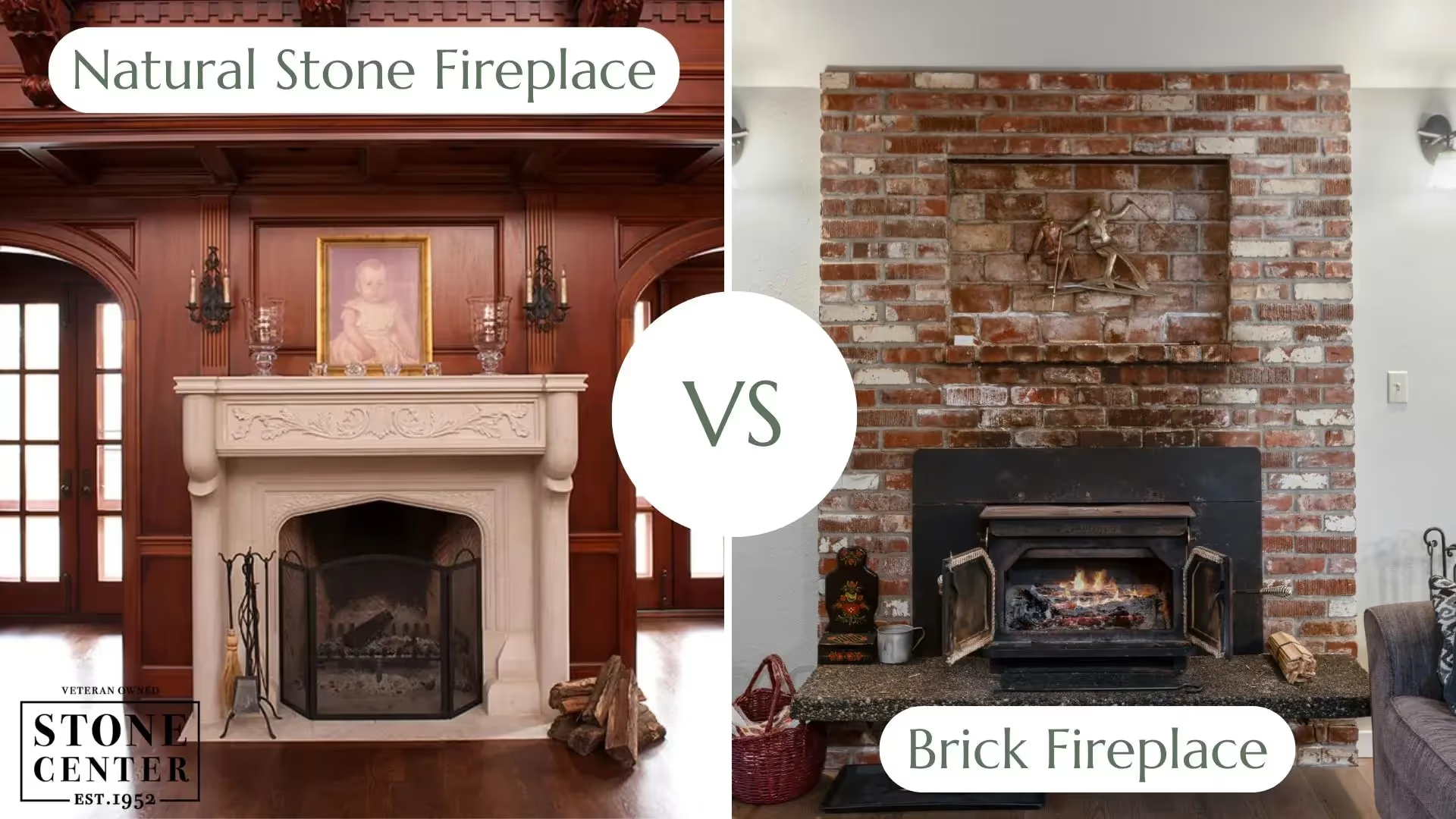
Natural Stone Fireplaces: Timeless Elegance
Natural stone fireplaces bring unmatched character through unique textures, colors, and patterns that make your fireplace surrounds truly one-of-a-kind. Natural stone fireplace surrounds offer a more modern aesthetic compared to brick fireplaces, complementing both traditional and contemporary home styles.
✅ These standout features make natural stone a lasting favorite:
- Withstands high heat and stays warm longer
- Easy to clean and resists stains
- Each piece has unique natural variation
- Adds strong resale value to your home
- Retains and releases heat over time
❌ Consider these drawbacks before you choose stone:
- More expensive than brick options
- Requires professional installation
- Repairs can be difficult to match
- Takes longer to install
Brick Fireplace Options: Classic American Style
Brick fireplaces embody the traditional American home aesthetic with a uniform appearance that creates order and familiarity. The installation of brick fireplaces is simpler due to the consistent shape and size of bricks, making them more straightforward to work with than irregular natural stone.
✅ These advantages make brick a dependable, flexible option:
- Costs less and lasts for decades
- Easier for skilled DIY installation
- Simple to repair brick by brick
- Classic look suits most interiors
- Can be painted or updated easily
❌ A few drawbacks come with brick fireplaces:
- Needs frequent cleaning
- Holds less heat than stone
- May look outdated over time
- Absorbs stains quickly
Cost Breakdown: Stone vs. Brick Investment
Understanding the true cost difference helps you budget accurately and avoid surprises during your fireplace project. Let's examine material costs, installation expenses, and long-term value considerations to provide you with a comprehensive financial picture.
The financial investment varies significantly between brick and stone fireplaces. We’ve provided a detailed breakdown of material costs per square foot and home value considerations:
When considering the complete investment, natural stone fireplaces typically range from $4,550 to $7,500, while brick fireplaces average $3,500 to $5,000. Hidden costs, such as permits, chimney work, and site preparation, can add $1,000-$5,000 to your fireplace budget. For example, Ohio fireplace permits and inspections typically range from $150-$400, depending on the county and scope of work.
Factor-by-Factor Comparison
Installation complexity, maintenance needs, and long-term performance all factor into costs. Understanding these differences can help you make an informed decision between brick and natural stone fireplaces. Let's examine each factor so you know what to expect.
Appearance
Natural stone fireplaces offer unparalleled aesthetic versatility through infinite color, texture, and pattern combinations. Each installation becomes a unique piece of artwork that complements any architectural style. Natural stone fireplace surrounds create dramatic focal points that enhance room proportions and add beautiful character.
Brick fireplaces provide classic, uniform appeal, working well with traditional and transitional designs. Geometric regularity creates visual stability and warmth, while laying patterns add subtle interest. Their predictable appearance coordinates easily with existing architectural elements and furnishings.
Installation Process Complexity
Natural stone fireplace installation requires professional expertise because of irregular shapes and weights. The process typically takes 7-10 days, including site assessment, stone cutting, dry fitting, installation, and sealing. Each piece must be individually fitted, making it labor-intensive. However, the result is stunning custom fireplace surrounds.
Brick fireplace installation follows a predictable 3-5 day timeline thanks to uniform dimensions. The streamlined process includes foundation preparation, layout planning, brick laying, and finishing. This simplicity makes brick accessible to skilled DIYers while maintaining professional and high-quality results.
Maintenance Requirements over Time
Natural stone fireplaces require minimal ongoing attention, with bi-annual cleaning using pH-neutral cleaners and professional sealing every 3-5 years ($200-400). Structural inspections every 5-10 years ensure longevity, with occasional spot repairs needed. This stone fireplace's low-maintenance nature appeals to busy homeowners.
Brick fireplaces demand more regular care due to porous surfaces. Monthly inspections, quarterly deep cleaning with warm water, and annual mortar maintenance are essential. Professional repointing every 10-15 years ($500-1,200) maintains structural integrity while preventing soot buildup and staining issues.
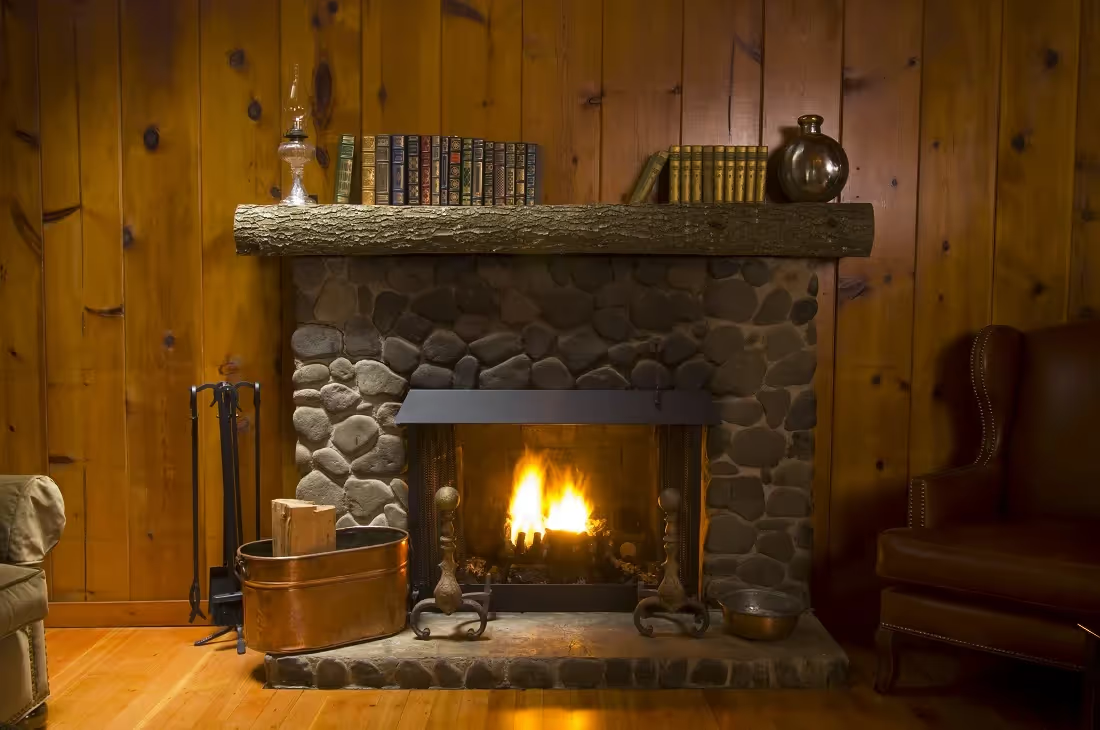
Durability and Heat Performance
When it comes to long-term durability, both natural stone and brick are strong performers, but stone typically edges out in resilience. Natural stone resists high temperatures better and retains heat longer, making it ideal for wood-burning fireplaces where intense heat is a factor. Brick, while durable, may crack or discolor over time under extreme heat. However, it still offers reliable function for decades with proper care.
Here's how stone and brick compare across common fireplace setups:
- Wood burning fireplaces: Both materials work well, but stone has slight advantages in heat retention and temperature resistance.
- Outdoor fireplaces: Stone typically offers better weather resistance, while brick provides classic outdoor living space appeal at a lower cost.
- Gas fireplaces: Both materials work equally well since heat levels are more controlled and consistent.
Climate Considerations
Natural stone performs exceptionally in varied climates, from harsh Midwest winters to humid summers. Low porosity resists freeze-thaw damage, while thermal mass moderates temperature fluctuations. Stone fireplace surrounds improve with age, developing an attractive patina that enhances natural beauty over decades.
Brick handles climate variations adequately but requires more maintenance in extreme conditions. Freeze-thaw cycles accelerate mortar deterioration, while high humidity promotes efflorescence. Quality installations with proper pointing perform reliably, though more attention is needed than with stone.
Design Considerations: Which Suits Your Home Style?
There’s no right or wrong answer. Ultimately, the choice between brick and natural stone fireplaces depends largely on your home's architectural character and personal design preferences.
Brick traditionally complements colonial, craftsman, and farmhouse styles with its geometric patterns and classic appeal, while natural stone adapts beautifully to rustic, contemporary, and transitional designs through organic textures and varied patterns. Natural stone fireplace surrounds suit any style or space, from cozy rooms to grand outdoor areas. They adapt to your vision while offering timeless beauty and design flexibility.
Want some design inspiration? Explore our portfolio to see stone fireplaces that elevate everything from classic charm to modern drama. Each design transforms everyday spaces into stunning, personalized showpieces:
#gallery_start
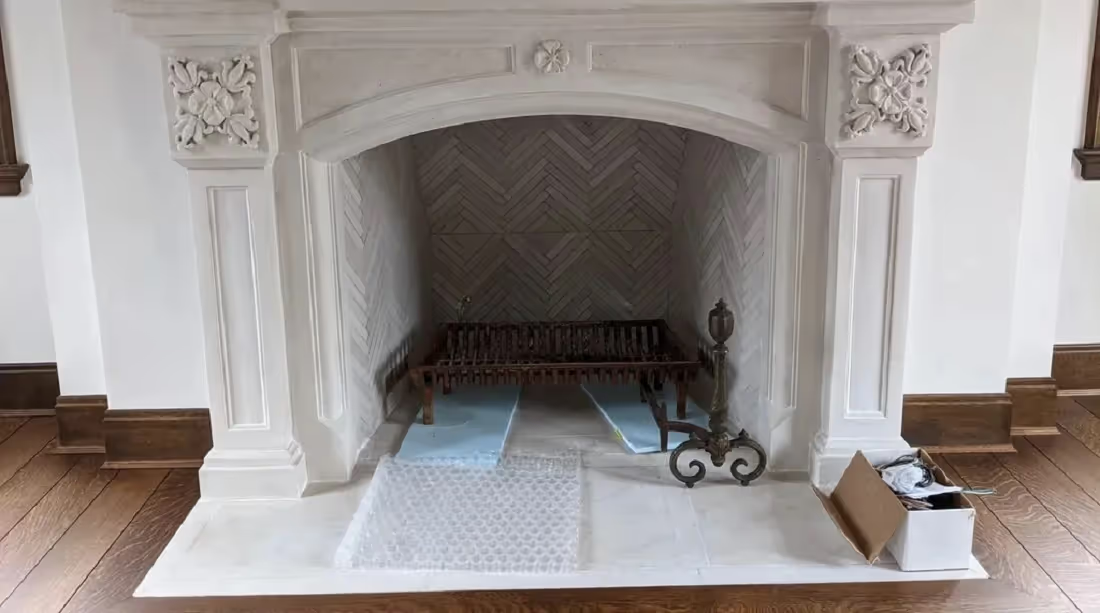

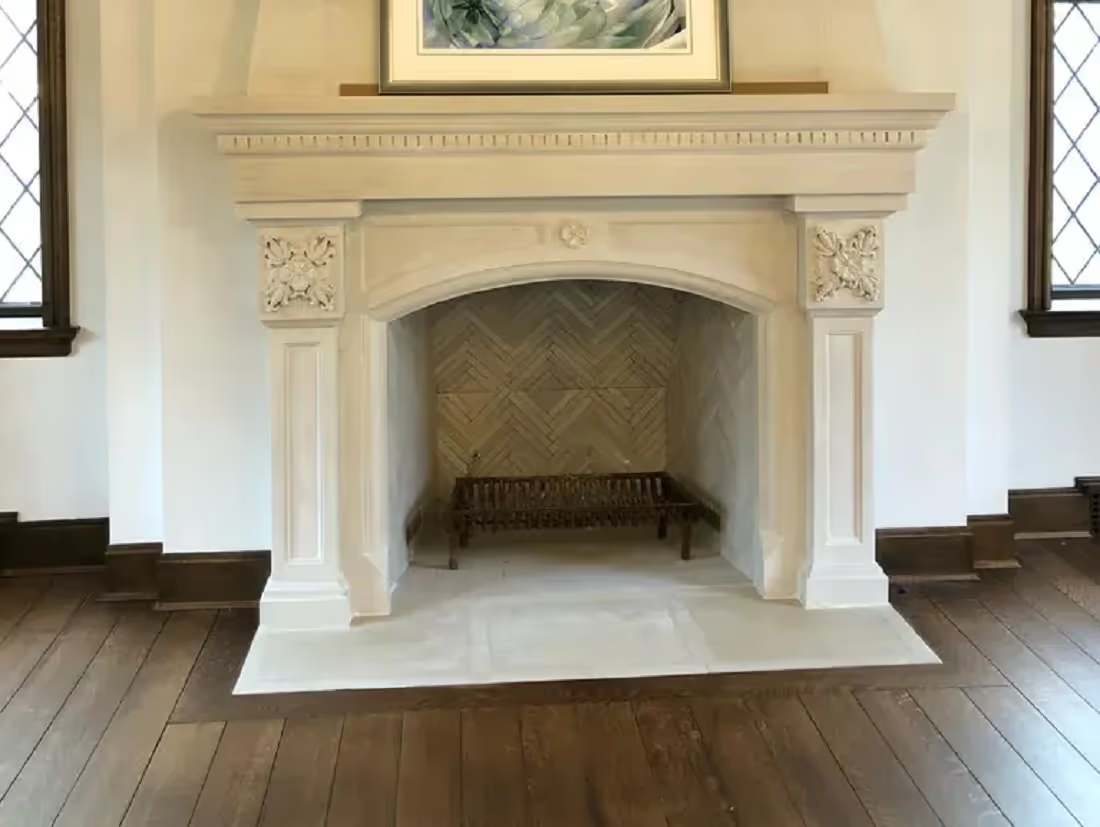
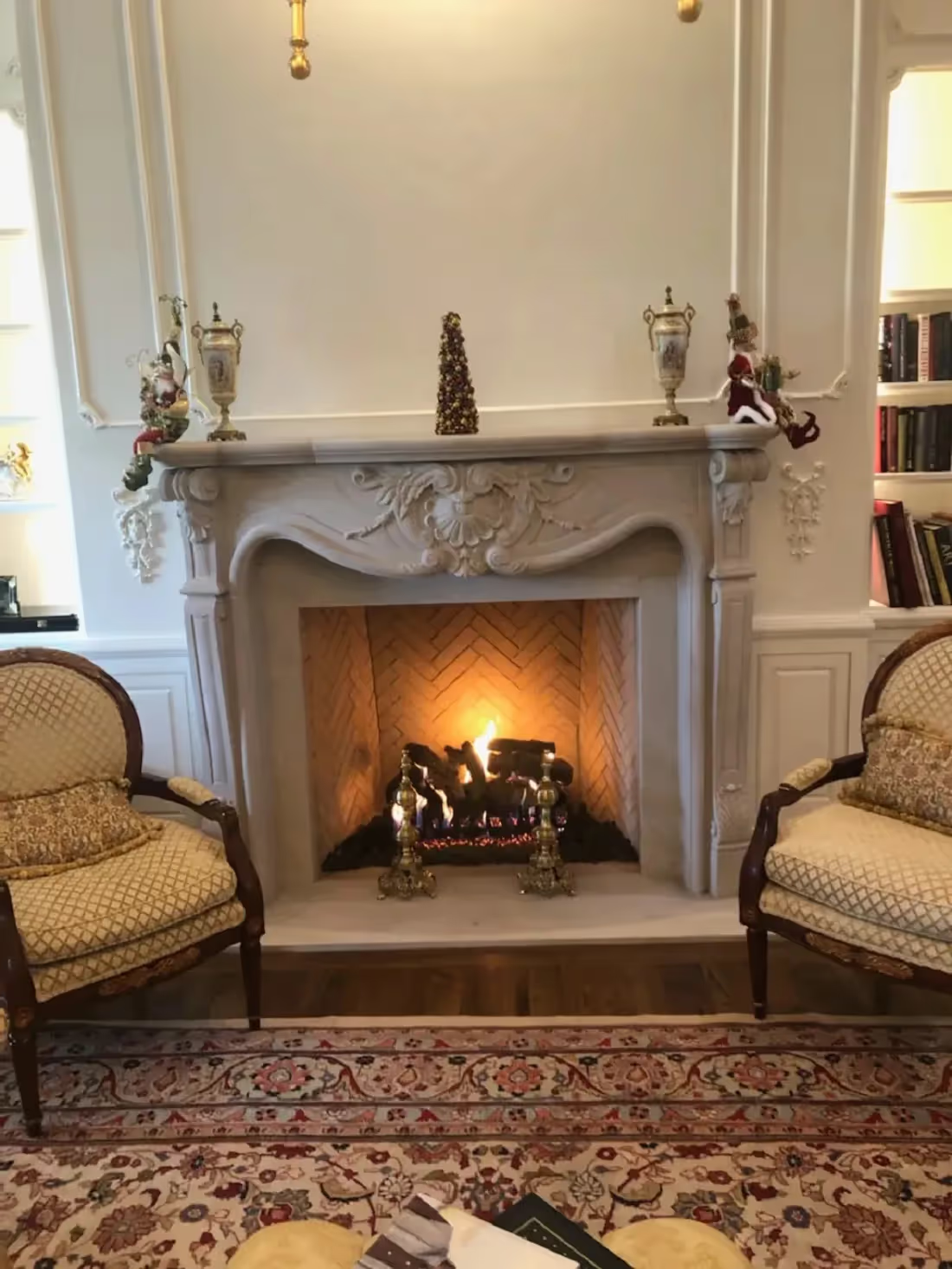
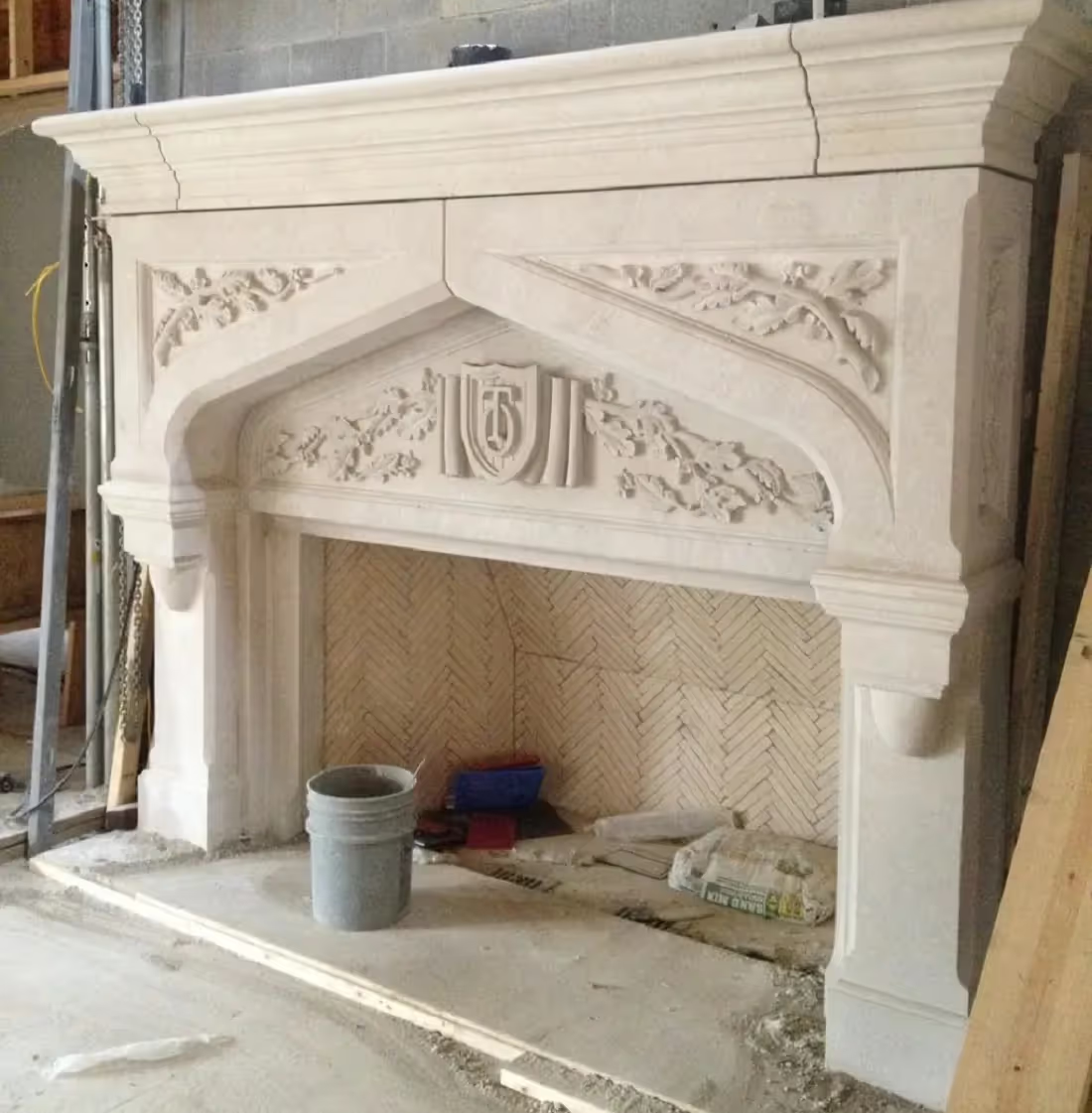
#gallery_end
Stone Veneer: A Compromise Option
Stone veneer is an appealing middle-ground solution for homeowners who want stone’s natural beauty without the full investment of solid stone construction. This thin layer of authentic stone applied over a substrate delivers much of stone's aesthetic appeal while reducing costs and installation complexity.
- Cost effectiveness: Reduces material costs by 40-60% compared to full stone, while maintaining natural appearance and texture variations.
- Lighter weight: Requires less structural support than solid stone, making it suitable for existing construction and upper-level installations.
- Easier installation: Professional installation remains recommended, but the process requires less time and specialized equipment than full stone construction.
- Design flexibility: Available in various stone types and patterns, allowing customization to match your aesthetic preferences and architectural needs.
- Retrofit compatibility: Can be applied over existing brick fireplaces during renovation projects, providing an affordable upgrade path to achieve the stone look.
While stone veneer doesn't provide the same thermal mass or longevity as solid natural stone, it offers an excellent compromise between aesthetic appeal and budget considerations for many homeowners wanting the beauty of natural stone fireplace surrounds.
Making Your Decision: Questions to Consider
When choosing the best material for your fireplace, ask yourself:
- What's your budget range? Brick offers excellent value, while stone provides premium aesthetics at a higher cost.
- How much maintenance do you want to commit to? Stone is generally lower maintenance than brick.
- What style best fits your home? Consider your existing architecture and decor.
- Are you planning to sell soon? Both materials add value, but stone often commands a premium in resale markets.
Regardless of whether you choose brick or stone, professional installation is crucial for both safety and longevity. Fireplaces involve structural, ventilation, and safety considerations that require expertise. Think of it as a worthwhile investment, as a properly installed fireplace should provide decades of safe, enjoyable use.
Ready to Create Your Dream Fireplace?
You’re in the right place! Whether you choose the natural elegance of stone or the traditional warmth of brick, your fireplace will become a timeless focal point where family and friends naturally gather. Both materials have graced Midwestern homes for generations, creating memories around countless winter evenings.
Ready to start planning your dream fireplace? Stone Center can help you explore natural stone fireplace surrounds options to create the perfect centerpiece for your home. With over 70 years of experience serving Ohio homeowners, we understand what makes a fireplace both beautiful and functional for your needs. Contact us to schedule your consultation and discover how natural stone fireplace surrounds can transform your space!
FAQ
.avif)
Jon, the owner of Stone Center, is a knowledgeable expert in natural stone products, specializing in various types of stone for landscaping and architectural projects. Passionate about promoting the beauty and versatility of natural stone, Jon aims to use these blogs to inspire readers with creative ideas to upgrade their homes.
How much does it cost to get a stone restored?
How much you end up spending to restore stone varies on the type of stone, the technique, and the stone’s current condition. Stone in good condition will cost less to restore, whereas stone that has a lot of wear and tear may require a longer restoration.




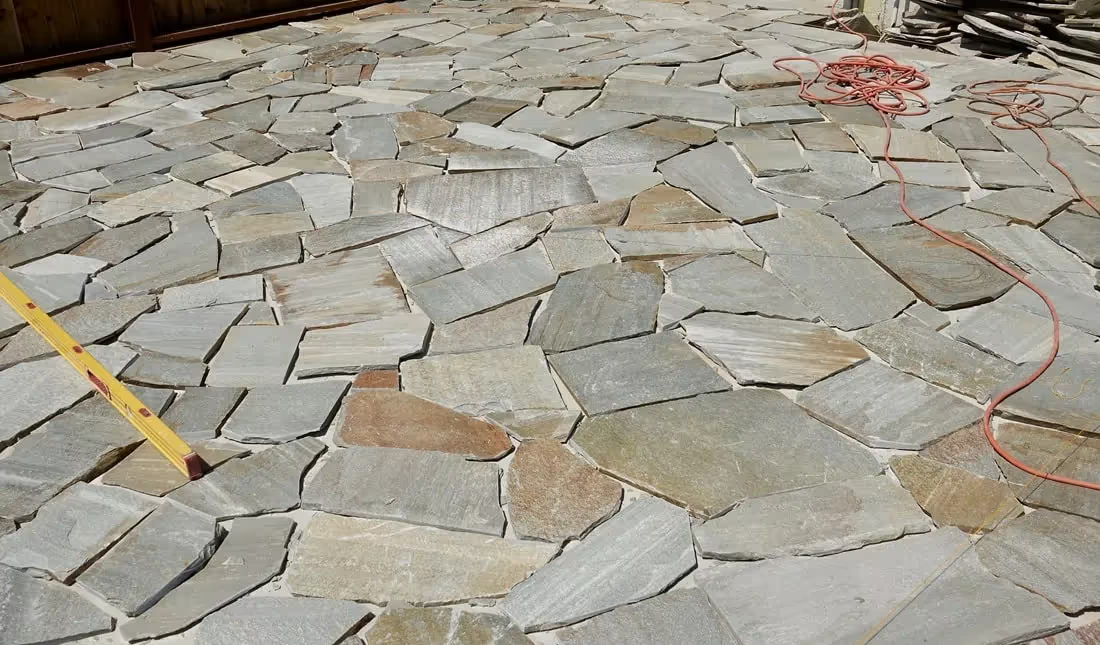


%20(1).avif)
.avif)
.avif)
.avif)
.avif)
